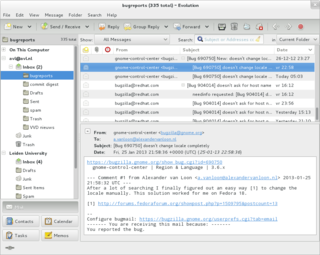Related Research Articles

Electronic mail is a method of transmitting and receiving messages using electronic devices. It was conceived in the late–20th century as the digital version of, or counterpart to, mail. Email is a ubiquitous and very widely used communication medium; in current use, an email address is often treated as a basic and necessary part of many processes in business, commerce, government, education, entertainment, and other spheres of daily life in most countries.
Kerberos is a computer-network authentication protocol that works on the basis of tickets to allow nodes communicating over a non-secure network to prove their identity to one another in a secure manner. Its designers aimed it primarily at a client–server model, and it provides mutual authentication—both the user and the server verify each other's identity. Kerberos protocol messages are protected against eavesdropping and replay attacks.

Stephen D. Crocker is an Internet pioneer. In 1969, he created the ARPA "Networking Working Group" and the Request for Comments series. He served as chair of the board of the Internet Corporation for Assigned Names and Numbers (ICANN) from 2011 through 2017.
Telnet is a client/server application protocol that provides access to virtual terminals of remote systems on local area networks or the Internet. Telnet consists of two components: (1) the protocol itself which specifies how two parties to communicate and (2) the software application that provides the service. User data is interspersed in-band with Telnet control information in an 8-bit byte oriented data connection over the Transmission Control Protocol (TCP). Telnet was developed in 1969 beginning with RFC 15, extended in RFC 855, and standardized as Internet Engineering Task Force (IETF) Internet Standard STD 8, one of the first Internet standards. Telnet transmits all information including usernames and passwords in plaintext so it is not recommended for security-sensitive applications such as remote management of routers. Telnet's use for this purpose has waned significantly in favor of SSH. Some extensions to Telnet which would provide encryption have been proposed.
In computing, Internet Protocol Security (IPsec) is a secure network protocol suite that authenticates and encrypts packets of data to provide secure encrypted communication between two computers over an Internet Protocol network. It is used in virtual private networks (VPNs).

An email client, email reader or, more formally, message user agent (MUA) or mail user agent is a computer program used to access and manage a user's email.
Transport Layer Security (TLS) is a cryptographic protocol designed to provide communications security over a computer network. The protocol is widely used in applications such as email, instant messaging, and voice over IP, but its use in securing HTTPS remains the most publicly visible.
Sender Policy Framework (SPF) is an email authentication method designed to detect forging sender addresses during the delivery of the email. SPF alone, though, is limited to detecting a forged sender claim in the envelope of the email, which is used when the mail gets bounced. Only in combination with DMARC can it be used to detect the forging of the visible sender in emails, a technique often used in phishing and email spam.
Simple Authentication and Security Layer (SASL) is a framework for authentication and data security in Internet protocols. It decouples authentication mechanisms from application protocols, in theory allowing any authentication mechanism supported by SASL to be used in any application protocol that uses SASL. Authentication mechanisms can also support proxy authorization, a facility allowing one user to assume the identity of another. They can also provide a data security layer offering data integrity and data confidentiality services. DIGEST-MD5 provides an example of mechanisms which can provide a data-security layer. Application protocols that support SASL typically also support Transport Layer Security (TLS) to complement the services offered by SASL.
In the context of an HTTP transaction, basic access authentication is a method for an HTTP user agent to provide a user name and password when making a request. In basic HTTP authentication, a request contains a header field in the form of Authorization: Basic <credentials>, where credentials is the Base64 encoding of ID and password joined by a single colon :.

Digest access authentication is one of the agreed-upon methods a web server can use to negotiate credentials, such as username or password, with a user's web browser. This can be used to confirm the identity of a user before sending sensitive information, such as online banking transaction history. It applies a hash function to the username and password before sending them over the network. In contrast, basic access authentication uses the easily reversible Base64 encoding instead of hashing, making it non-secure unless used in conjunction with TLS.
Email authentication, or validation, is a collection of techniques aimed at providing verifiable information about the origin of email messages by validating the domain ownership of any message transfer agents (MTA) who participated in transferring and possibly modifying a message.
DomainKeys Identified Mail (DKIM) is an email authentication method designed to detect forged sender addresses in email, a technique often used in phishing and email spam.

In cryptography, a nonce is an arbitrary number that can be used just once in a cryptographic communication. It is often a random or pseudo-random number issued in an authentication protocol to ensure that old communications cannot be reused in replay attacks. They can also be useful as initialization vectors and in cryptographic hash functions.
Domain-based Message Authentication, Reporting and Conformance (DMARC) is an email authentication protocol. It is designed to give email domain owners the ability to protect their domain from unauthorized use, commonly known as email spoofing. The purpose and primary outcome of implementing DMARC is to protect a domain from being used in business email compromise attacks, phishing email, email scams and other cyber threat activities.

Barry Leiba is a computer scientist and software researcher. He retired from IBM's Thomas J. Watson Research Center in Hawthorne, New York in February 2009, and now works for FutureWei Technologies as a Director of Internet Standards. His work has focused for many years on electronic mail and anti-spam technology, on mobile computing and the Internet of things, and on Internet standards.
SMTP Authentication, often abbreviated SMTP AUTH, is an extension of the Simple Mail Transfer Protocol (SMTP) whereby a client may log in using any authentication mechanism supported by the server. It is mainly used by submission servers, where authentication is mandatory.
DNS Certification Authority Authorization (CAA) is an Internet security policy mechanism that allows domain name holders to indicate to certificate authorities whether they are authorized to issue digital certificates for a particular domain name. It does this by means of a new "CAA" Domain Name System (DNS) resource record.
Murray S. Kucherawy is a computer scientist, mostly known for his work on email standardization and open source software.
References
- ↑ "LinkedIn". LinkedIn.com. October 2021. Retrieved 25 November 2021.
- ↑ Phillip Hallam-Baker (20 December 2007). the dotCrime Manifesto: How to Stop Internet Crime. Addison-Wesley Professional. ISBN 978-0321503589 . Retrieved 3 June 2014.
- ↑ "6.857: Computer and Network Security". mit.edu. MIT. 2013. Retrieved 3 June 2014.